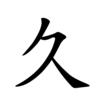久
See also: 乆
| ||||||||
Translingual
| Stroke order | |||
|---|---|---|---|
| Stroke order | |||
|---|---|---|---|
 | |||
Han character
久 (radical 4, 丿+2, 3 strokes, cangjie input 弓人 (NO) or X弓人 (XNO), four-corner 27800, composition ⿸𠂊乀)
Descendants
- く (Hiragana character derived from man'yōgana)
- ク (Katakana character derived from man'yōgana)
- 𛀫 (Hentaigana)
- 𛀬 (Hentaigana)
References
- KangXi: page 81, character 19
- Dai Kanwa Jiten: character 118
- Dae Jaweon: page 165, character 6
- Hanyu Da Zidian: volume 1, page 33, character 3
- Unihan data for U+4E45
Chinese
| simp. and trad. |
久 | |
|---|---|---|
| variant forms | 乆 | |
Glyph origin
| Historical forms of the character 久 | |||||||||||||||||
|---|---|---|---|---|---|---|---|---|---|---|---|---|---|---|---|---|---|
| |||||||||||||||||
|
References: Mostly from Richard Sears' Chinese Etymology site (authorisation),
|
| Characters in the same phonetic series (久) (Zhengzhang, 2003) | |
|---|---|
| Old Chinese | |
| 畂 | *ɡʷ·rɯs |
| 久 | *kʷlɯʔ |
| 灸 | *kʷlɯʔ, *kʷlɯs |
| 玖 | *kʷlɯʔ |
| 疚 | *kʷlɯs |
| 柩 | *ɡʷlɯs |
| 羑 | *ɡʷ·lɯʔ |
Pictogram (象形) - a man receiving moxibustion. The derivative 灸 refers to the original word.
Pronunciation
Definitions
久
Compounds
Derived terms from 久
|
|
|
Japanese
Readings
Korean
Vietnamese
Han character
References
- Bonet (1899).
- Taberd & Pigneau de Béhaine (1838).
- Trần (2004).
- Génibrel (1898).
This article is issued from
Wiktionary.
The text is licensed under Creative
Commons - Attribution - Sharealike.
Additional terms may apply for the media files.
















